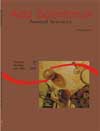<b>Components of live weight, carcass and meat caracteristics of lambs fed with diets containing corn grain silage</b> - DOI: 10.4025/actascianimsci.v31i2.3451
Keywords:
physical characteristics, extra-carcass, sheep
Abstract
The study evaluated the live weight components, objective and subjective carcass characteristics and physical-chemical characteristics of the Longissimus lumborum muscle and the proportion of tissues that constitute the loin of twenty-four intact males lambs, Hampshire Down crossbreed, fattened in a drylot system. The lambs were fed with different diets based on corn grain silage with the addition of sunflower seeds or urea. The treatments did not affect live weight and hot carcass weight at slaughter, carcass yield, blood, skin, reproductive system with bladder, respiratory system, spleen, kidneys and perineal fat, liver, heart, empty gastrointestinal tract, head or feet. There was no significant difference in cold carcass weight, body condition, conformation of carcass, fat covering, fat consistency, meat color, thickness, loin area, crude protein, or ratios of muscle, bones, fat and other tissues of the Longissimus lumborum muscle. Cooking losses, myofibril fragmentation index and colors indexes L*, a* and b*, also did not differ by treatment. The lambs can be fattened with any diets, because there is no difference for the analyzed characteristicsDownloads
Download data is not yet available.
Published
2009-08-11
How to Cite
Andrade, M. B., Macedo, F. de A. F., Jobim, C. C., Lombardi, L., Macedo, F. G., & Gasparino, E. (2009). <b>Components of live weight, carcass and meat caracteristics of lambs fed with diets containing corn grain silage</b> - DOI: 10.4025/actascianimsci.v31i2.3451. Acta Scientiarum. Animal Sciences, 31(2), 183-189. https://doi.org/10.4025/actascianimsci.v31i2.3451
Issue
Section
Animal Production
DECLARATION OF ORIGINALITY AND COPYRIGHTS
- I Declare that current article is original and has not been submitted for publication, in part or in whole, to any other national or international journal.
The copyrights belong exclusively to the authors. Published content is licensed under Creative Commons Attribution 4.0 (CC BY 4.0) guidelines, which allows sharing (copy and distribution of the material in any medium or format) and adaptation (remix, transform, and build upon the material) for any purpose, even commercially, under the terms of attribution.
Read this link for further information on how to use CC BY 4.0 properly.
0.9
2019CiteScore
29th percentile
Powered by 








































